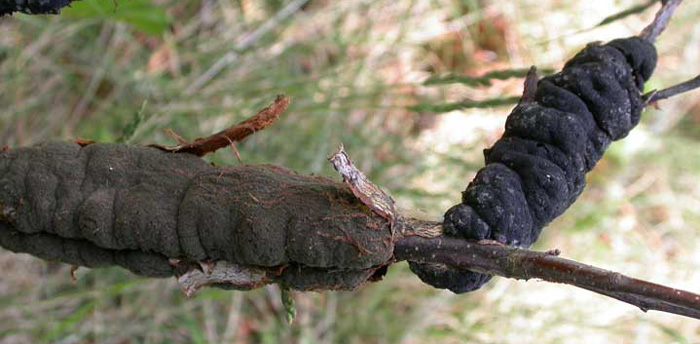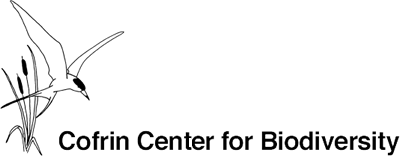

Host-Fungus Index of Wisconsin
by Virginia Day and V.M.G. Nair
The Host-Fungus Index of Wisconsin is a list of all the fungi reported on plants in the State of Wisconsin, including parasitic, saprophytic, and beneficial fungi, including mycorrhyzae.
The index is arranged alphabetically by plant host species. The newest genus names of both plant hosts and fungi are given, as well as any synonyms of those genera. Every name is listed just as it was reported, along with authors for both plants and fungi. Over 10,000 fungi are included in this index, compared to 1500 recorded in Greene’s Host Index of Wisconsin that was published in 1953.
This guide is arranged alphabetically by the Latin name of the host plant. To use the guide click on the letter that corresponds to the genus name of the host plant species to download a pdf list of that includes that plant host's associated fungi.
| A | B | C | D | E | F | G | H | I | J | K | L | M | N | O | P | Q | R | S | T | U | V | W,X,Y | Z |
|---|
Introduction
The major objective is to bring out a "Host and Fungus Index of Wisconsin" with a complete list of all fungi recorded on host plants grown in the State of Wisconsin, U.S.A. With the explosion of knowledge in the field of host-parasite interactions, there is a great demand for the recognition of Fungi on various plant host species in the State of Wisconsin.
Early studies on parasitic fungi on plants in Wisconsin started under the leadership of William Trelease, who published a "Preliminary list of Wisconsin Parasitic Fungi" in a paper of some 40 pages. Soon Dr. J.J. Davis conducted one of the most extensive studies on Parasitic Fungi in Wisconsin and they were published in a series of 26 papers. After the demise of Dr. Davis in 1937 Dr. H.C. Greene of the Department of Botany, University of Wisconsin, continued the listings of Parasitic Fungi and published 14 papers, mainly based on his collections from southern counties of Wisconsin. All these valued 3 works are:
- Wm. Trelease's List of Wisconsin Parasitic Fungi
- J.J. Davis's "Supplementary List of Parasitic Fungi of Wisconsin," "a provisional list of Parasitic Fungi of Wisconsin," and "Notes on Parasitic Fungi in Wisconsin" which includes 26 papers.
- H.C. Greene's "Notes on Wisconsin Parasitic Fungi." All these 3 works are included in the Reference section.
Our "Host and Fungus Index of Wisconsin" contains over 10,000 fungi recorded, compared to almost 1500 fungi recorded in H.C. Greene's "Host Index of Parasitic Fungi collected on plants in Wisconsin (1880-1950)." This new index will enhance the knowledge of those who are involved in the field of research and teaching of Mycology and Plant-Forest Pathology.
Hosts
Common names of hosts are not included in this present "Host-Fungus Index of Wisconsin." According to the International Rules of Nomenclature, scientific names of hosts are included and arranged alphabetically, and in most cases synonyms of hosts are incorporated, along with authorities in both cases.
Fungi
The present Host-Fungus Index includes mainly both parasitic and saprophytic fungi reported on various host plants in the State of Wisconsin, as well as beneficial fungi, such as mycorrhyzae. Bacteria, viruses, viroids, and phytoplasmas are not included in this host index, though they cause many diseases on plants and fungi. Host plants are arranged alphabetically, and under each host, the fungi reported are arranged also in alphabetical order. Many excellent monographs of various fungi published in journals are available in outstanding institutions. In addition, the starting points of Fungal Groups (not included in this book) are already recorded in (1) Linnaeus' (1953) "Species Plantarm" for Lichens and Myxomycetes, (2) Persoon's (1801), "Synopsis Methodica Fungorum" for Rusts, Smuts and Gastromycetes, (3) Fries' "Systema Mycologicum" for all the rest of the fungi. In addition, (4) Saccardo's "Syllogue Fungorum Omnium Hucusqui Cognitorum" in 26 volumes with its index and supplements; (5) Petrak's, "Petrak List" (1921 to 1940) as "Species Index", (6) Commonwealth Mycological Institute, Kew London England's "CMI Card Index," have added to our knowledge.
Fungi- Nomenclature
According to the International Latin Binomial System of Nomenclature Genus and Species Epithet represents perfect or imperfect stages of the fungus. When the genus epithet is followed by species epithet, in some cases, if two distinct words are used in the species epithet, a hyphon is used as in Sirococus clavigignenti-juglandacearum, along with authors name (Nair V.M.G., Kostichka, C. and Kuntz, J.E.). According to the rules of nomenclature, if the imperfect stage of the fungus was discovered and named as a genus epithet, it will be followed by the species epithet. However, later, if the perfect stage of the fungus was discovered, then the old genus name should be changed to a new genus based on the perfect stage. However, the species epithet should remain the same in most cases. In this index, imperfect stages of various fungi are recorded as synonyms in the presence of perfect stages.
In the case of the Dutch Elm Disease pathogen, it was named as genus Ceratocysistis, based on its perfect stage, followed by species epithet as Ceratocystis ulmi. Later a new genus name was given as Ophiostoma, due to a change in character of the perfect stage, but the species epithet remained as ulmi (Ceratocystis ulmi = Ophiostoma ulmi). Under different circumstances it should be noted that the Oak Wilt pathogen was named by Bretz as Chalara quercinia, based on the imperfect stage, reflecting its genus and species epithet. Later, with the discovery of (1) a perfect stage, and (2) due to the pathogen's ability to attack other hosts than Quercus, of the family Fagaceae, both genus and species names were changed to Ceratocystis fagacearum by Hunt, ie. Ceratocystis fagacearum (Bretz) Hunt.
Many important fungi are recorded in various Mycological Literature and Host Indexes. However, the present Host-Fungus Index has brought together for the first time over 10,000 fungi for quick reference. Fungi on Plants and Plant Products in the United States, by Gerald, D.F., Farr, D., Chamuris G., and Rossman, is a monumental work. It is a very time consuming process to go through numbers (1,2,3 etc) for host species recorded under each fungus. The states are listed as two-letter abbreviations (ie, WI, OR, etc) though they are well documented with great details including fungal classification. Mrs. Muriel Obrien's outstanding work in the compilation of "Index of Plant Diseases in the United States," Agricultural Handbook 165, covering diseases of various economically important crops, ornamentals, and graminicolous hosts, is now considered as one of the most valuable works in the field of Plant Pathology. In addition, the U.S.D.A./A.R.S. data base, along with the Commonwealth Mycological Institute "Card Index" Kew, London, England, provide up-to-date information, aiding all those scientists who are researching in various host parasite interactions in plant diseases.
The present "Host Fungus Index of Wisconsin" does not eliminate our need for the quick identification of fungi reported on various hosts in the State of Wisconsin for future research and teaching. All these aforesaid various mycological literature have aided immensely in the preparation of our present "Host Fungus Index of Wisconsin."
References and Additional information:
- References
- Introduction to Greene's Host-Fungus Index of Wisconsin published in 1953
- USDA Fungus-Host Database, Systematic Mycology and Microbiology Laboratory, ARS, USDA